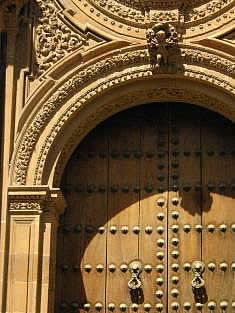
From Cadiz to Granada and Guadix
We went from Cadiz to Granada intended to visit Granda city and of course Alhambra. Granada has almost in center of the city great camp with camping places and accommodation in bungalows. First we reservated tickets for visit Alhambra then built tent and then we had a time to make an easy trip. We decided for a tour to Guadix. Guadix is a small city inland from Almeria city, and is famous for its cave houses.
The most interesting feature of the Guadix area is that almost half of the inhabitants live in cave homes. In ochre colored terrain and the snow white chimneys of the caves contrast with the peaks of the Sierra Nevada. The cave district is signposted on the main street of the town as the "Barrio Troglodyte". Another intersting thigs is that British and American tourists have even bought cave houses as holiday homes.
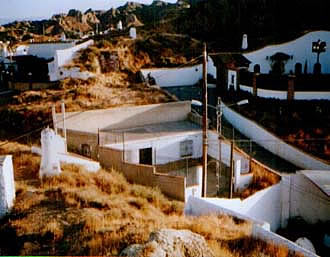 Guadix
Guadix
A land of contrasts in the north-east of the province, where the arid desert landscape mixes with fertile plains and mountainous sierras. This is an extremely large area covering the north-east of the province of Granada, a land of huge contrasts, where the arid desert landscape mixes with fertile plains and the mountainus sierras surrounding them. This vast area is formed by two large regions: The region of Guadix y Marquesado del Zenete and the region of the Altiplano (High Plateau). The layey composition of most of the soil has encouraged the existence of cave houses, a typical and distinct home in this area. As the moment, many of them are used a rural accommodation. The capital of the first of these regions is Guadix
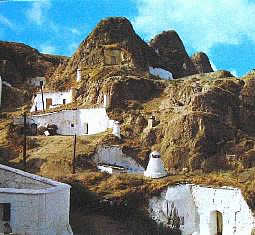 Cave houses in Guadix
Cave houses in Guadix
The cave houses have been built in Guadix for over a thousand years. They were hollowed out of the rock and then a wall would be built at the front of the cave to enclose it.
The cave houses were perfect for this climate because of heat during the day and cool at the night. Cave homes were popular for hundreds of years until the 20th century, when people decided to move out to classic houses. Today the cave houses are not homes from stone age (as we maybe expect) instead, the Guadix cave houses has most of the modern conveniences of any 21st century house. Many of them have furnished with marble floors, fully fitted kitchens and bathrooms, cable TV, internet...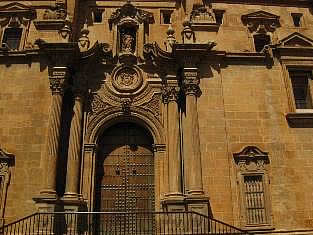 Cathedral in Guadix
Cathedral in Guadix
Construction work began in the 16th century and continued ontermittently until the 18th century. All the major architectural styles of the Modern Age – Gothic, Renaissance, Baroque and neo-Classical are represented. The foundations were laid on the site of what had been the city's principal mosque, to which a first Gothic body was added betwneen 1510 and 1521.
Shortly afterwards the building was enlarged with another body of the same style. In 1549 Diego Siloe began a new Renaissance project for the apse, and the perimeter walls of the apse aisle, the lower body of the tower and the round chapel of San Torcuato also correspond to this period. The sacristy and the tower, with its belfrty bearing the date 1710, were eventually completed after a long delay. Most of the cathedral's structure and external appearance date from the 18th century when, from 1713 onwards, the architects Vicente Acero, Gaspar Cayon and Fernandez Pachote executed their own original designs in what was a marvellous job of integration and harmonization of the earlier elements with the more recent structures.
Contributions were also made during this stage by Blas Antonio Delgado y Hurtado Izquierdo. The parts of the building erected in the 16th century exerted a decisive influence over some of the later works, such as the gothic vaults and the original arrangment of the columns in the nave and aisles, adorned with Corinthian and Doric capitels at the same time. Baroque additions to the interiro included the elegant main chapel and the dome. Outside, the Santiago gate and, especially, the main facade are particularly interesting due to the original positions of the leaning buttressees and the imaginative decoration, which turn it into an architectural screen of great plastic expressivity. Ceremonial furnishings of note include the pulpits and the choir stalls, which reflect the involvement of Torcuato Ruiz del Peral, and numerous 18th century Baroque altarpieces, paintings and sculptures. The neo-Classical retrochoir and tabernacle were designed by Domingo Lois. The modern Cathedral Museum contains a number of exhibits, including a magnificent collection of gold and silver items.
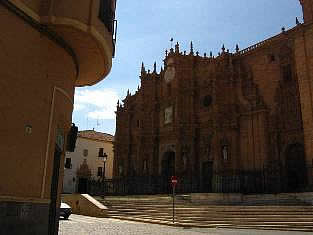 PLAZA DE LA CONSTITUCIÓN
OR PLAZA DE LAS PALOMAS
PLAZA DE LA CONSTITUCIÓN
OR PLAZA DE LAS PALOMAS
This square is one of old Guadix's more successful urban creations, although the uniform appearance it displays today, completely enclosed by porticoes, is the result of a mid 19th century plan to remodel the site in a more historical vein. During the Moorish period the area would have been full of trading stalls, workshops and storage buildings, near what is known as the Puerta Alta de Baza, one of the city's most important gates.
To the north and east there was a medieval rampart, remains of which have recently appeared together with others of Roman origin. The area is clearly of considerable historical interest. In the 16th century. The space became a focal point for politics and festivities similar to the Plazas Mayores of Castile, and numerous buildings were erected in or around it: the Town Hall, the Gaol, the Corregidoria (residence of the Corregidor, or monarch's representative), butchers' shops, and abattoir, a fish market, a corn exchange, a variety of shops and businesses, and the stocks for public punishments. Although the first shops had pillars standing in front of them, the monumental appearance began to materialize during the reign of Charles V. It was then when some of the arhes now standing on the north side of the square were built. They bear elegant coats-of-arms corresponding to the Emperor Charles and the devices of the Catholic Monarchs. These, which coincide with those of the city of Gudaix, were later copied onto the modern arhes. The Town Hall presently displays the reconstructed row of balconies which until the 1940s stood opposite as part of the Corregidoria, with coats-of-arms corresponding to the King, Guadix and the Corregidor. It also bears an institutional inscription with the date 1606.